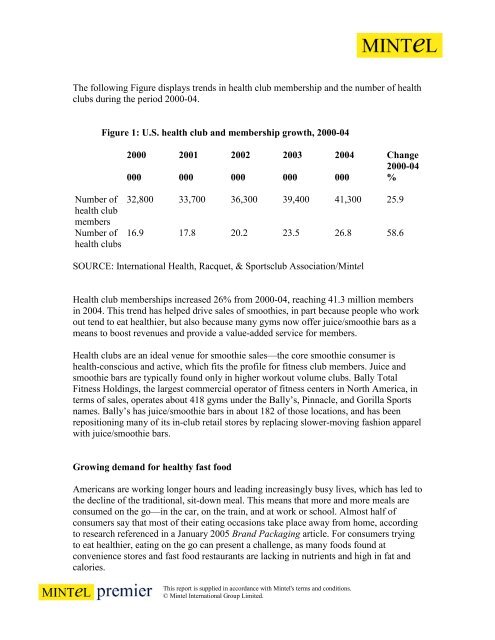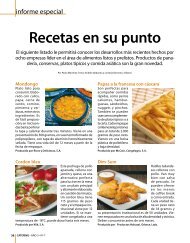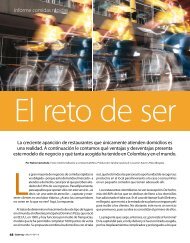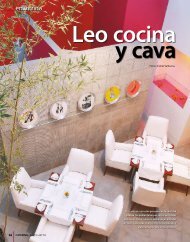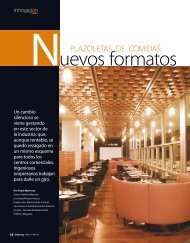The following Figure displays trends in health club membership and the number of healthclubs during the period 2000-04.Figure 1: U.S. health club and membership growth, 2000-042000 2001 2002 2003 2004 Change2000-04000 000 000 000 000 %Number ofhealth clubmembersNumber ofhealth clubs32,800 33,700 36,300 39,400 41,300 25.916.9 17.8 20.2 23.5 26.8 58.6SOURCE: International Health, Racquet, & Sportsclub Association/MintelHealth club memberships increased 26% from 2000-04, reaching 41.3 million membersin 2004. This trend has helped drive sales of smoothies, in part because people who workout tend to eat healthier, but also because many gyms now offer juice/smoothie bars as ameans to boost revenues and provide a value-added service for members.Health clubs are an ideal venue for smoothie sales—the <strong>co</strong>re smoothie <strong>co</strong>nsumer ishealth-<strong>co</strong>nscious and active, which fits the profile for fitness club members. Juice andsmoothie bars are typically found only in higher workout volume clubs. Bally TotalFitness Holdings, the largest <strong><strong>co</strong>m</strong>mercial operator of fitness centers in North America, interms of sales, operates about 418 gyms under the Bally’s, Pinnacle, and Gorilla Sportsnames. Bally’s has juice/smoothie bars in about 182 of those locations, and has beenrepositioning many of its in-club retail stores by replacing slower-moving fashion apparelwith juice/smoothie bars.Growing demand for healthy fast foodAmericans are working longer hours and leading increasingly busy lives, which has led tothe decline of the traditional, sit-down meal. This means that more and more meals are<strong>co</strong>nsumed on the go—in the car, on the train, and at work or school. Almost half of<strong>co</strong>nsumers say that most of their eating occasions take place away from home, ac<strong>co</strong>rdingto research referenced in a January <strong>2005</strong> Brand Packaging article. For <strong>co</strong>nsumers tryingto eat healthier, eating on the go can present a challenge, as many foods found at<strong>co</strong>nvenience stores and fast food restaurants are lacking in nutrients and high in fat andcalories.This report is supplied in ac<strong>co</strong>rdance with Mintel's terms and <strong>co</strong>nditions.© Mintel International Group Limited.
Many time-pressed, health-minded <strong>co</strong>nsumers are finding that smoothies are a goodsolution. Made with fresh fruit and packed with nutrients, smoothies enjoy a healthyimage and can be easily <strong>co</strong>nsumed on the run. Many <strong>co</strong>nsumers are using smoothies as ameal replacement, typically for breakfast, and to a lesser extent, for lunch. At the sametime, to help drive morning sales, many smoothie chains are adding breakfast items totheir menus. Planet Smoothie, a 138-unit chain, introduced five new breakfast offeringsin <strong>2005</strong>, among them an Acai Energy Bowl, made with Acai, banana, apple juice, andgranola, as well as a Honey Oats Smoothie, which is <strong><strong>co</strong>m</strong>prised of a blend of cinnamon,oatmeal, honey and fruit.Last year Jamba Juice launched a line of Yogurt Blends smoothies geared for breakfast,followed in <strong>2005</strong> by a line of <strong>co</strong>ffee alternatives for <strong>co</strong>nsumers who do not want <strong>co</strong>ffee,but need a burst of energy to get them going in the morning. Jamba’s Energy <strong>Smoothies</strong>line includes: Matcha Green Tea Blast, a blend of green tea, soymilk, frozen yogurt andsorbet; Acai Supercharger, made with Acai juice, guarana, soymilk, raspberry sherbet,strawberries, blueberries and ice; and Turbo Tropic, a blend of mangoes, strawberries,peaches, orange and pineapple sherbet, pineapple juice, kiwi juice, ice and an EnergyBoost. These smoothies <strong>co</strong>ntain 15-75mg of caffeine per Original size serving.In addition to offering breakfast items, some smoothie chains are offering extensive foodmenus targeted at <strong>co</strong>nsumers seeking healthy food along with their drinks. Two chainsdoing so are Planet Smoothie and Tropical Smoothie. In 2004 Planet Smoothie opened itsfirst Planet Smoothie Café, offering light sandwiches, wraps, paninis, salads and achildren’s menu, in addition to a smoothie bar. There are currently seven Planet SmoothieCafés in operation. Tropical Smoothie Café, a 130-store chain based in Florida, offersgourmet wraps, sandwiches, tortizzas, salads, bagels and <strong>co</strong>ffee.Exotic flavors are hotAs Americans be<strong><strong>co</strong>m</strong>e more aware of ethnic and foreign cuisines, they are looking to trynew, unique flavors to add some variety to their diets. Many smoothie chains have addedexotic fruit flavors and ingredients to their menus to attract variety seekers. One of thehottest new ingredients is Acai, an antioxidant-rich berry that grows wild in the BrazilianAmazon. Another emerging ingredient is green tea—in March <strong>2005</strong> Jamba introduced aMatcha Green Tea Blast smoothie made with green tea, soymilk, frozen yogurt andsorbet.Smoothie King, the third-largest smoothie chain in the U.S., leveraged <strong>co</strong>nsumers’longing for unique, new flavors by launching a “<strong>Smoothies</strong> around the World” linefeaturing exotic ingredients including Acai, green tea, passion fruit, goji (a sweet, redberry that is a good source of antioxidants, minerals, and amino acids), and mangosteen(a purple, apple-size fruit that <strong>co</strong>ntains high levels of xanthones, a powerful antioxidant).This report is supplied in ac<strong>co</strong>rdance with Mintel's terms and <strong>co</strong>nditions.© Mintel International Group Limited.


